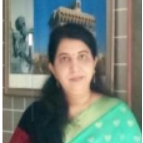
Snehlata Barde
Work place: MATS School of Information Technology, MATS University Raipur, Chhattisgarh, 492004, India
E-mail: drsnehlata@matsuniversity.ac.in
Website:
Research Interests:
Biography
Dr. Snehlata Barde is working as a Professor in the MATS school of Information technology at MAT'S University, Raipur, (C.G.). She holds a Ph.D. in IT &CA, from C.V.R. University, Bilaspur. MCA from Pt.Ravi Shankar Shukla University, Raipur, and MSc. (Maths) from Devi Ahilya University Indore. Her research interest includes Digital Image Processing and its Applications in Biometric Security, Forensic Science, Pattern Recognition, Segmentation, Simulation and Modulation, Fuzzy logic, Soft Computing Techniques, Cyber Crime, and IoT. She has published 75 research papers in various International and National Journals and Conferences. She has attained 36 seminars, workshops, and training programs, and she has published 6 Book Chapters and 1 Book in Springer and Elsevier. She got a certificate from CMI (Chartered Management Institute) Level 5 in “Management and Leadership”, UKIERI AICTE TECHNICAL LEADERSHIP PROGRAMME UK-India Education and Research Initiatives, from the British Council, and an NPTEL Certificate for reviewing the translated files of the course CLOUD COMPUTING offered by IIT Kharagpur. She got the “Manav Gaurav” award from the Human Wellness & Social Development Organization Chhattisgarh and Best Paper Award from AMET Deemed University Chennai. She is a member of IAENG (International Association of Engineers), Hong Kong, Universal Association of Computer and Electronics Engineers (UACEE), International Computer Science and Engineering Society (ICSES), and International Economics Development and Research Center (IEDRC). Indian Academicians and Researchers Association(IARA), Chartered Management Institute (CMI) in Management and Leadership with Dudley College of Technology UK. She has around 23 years of experience in teaching at technical institutes and universities.
Author Articles
Scientific Approach of Prediction for Professions Using Machine Learning Classification Techniques
By Snehlata Barde Sangeeta Tiwari Brijesh Patel
DOI: https://doi.org/10.5815/ijmecs.2023.04.03, Pub. Date: 8 Aug. 2023
Astrology is a very ancient and traditional method of prediction that increases the interest of people continuously. The globe today, there are no common guidelines or principles for astrological prediction. Rather than setting universal principles and criteria for astrological prediction, astrologers focus on providing high-quality services to individuals but there is no guarantee of accuracy. Machine learning is providing the best result for analysis and prediction on many applications by the learning of computers. Prediction and classification make it possible for any learner to work on large, noisy, and complex datasets. The main motive of the paper is to introduce a scientific approach that reduces the drawback of the traditional approach and indicates the universal rules of prediction and proves the validity of astrology by the three classification techniques, Naïve Bayes, Logistic-R, and J48. It is a part of supervision learning that operates with cross-validation 10,12, and 14fold for calculating the terms 1) correctly classified instances (CCI), erroneously categorized instances (ECI), Mean absolute error (MAE), Root mean squared error (RMSE), and Relative absolute error (RAE). 2) True Positive Rate, False Positive Rate, Precision, and F-Measure values. 3) The MCC, ROC, and PRC area values. 4) To calculate the average weight of the three-class label professor, businessman, and doctor in terms of true positive rate, false-positive rate, precision, F-measure, PRC, and ROC area, 5) finally, we calculated the accuracy of each classification technique and compare which provide the better result. For this, we have collected the date of birth, place of birth, and time of birth of 100 persons who belong to different professions. 40 data of professors, 30 data of businessmen, and 30 data of doctors, prepare the horoscope of an individual with the help of software. For analysis, we create the datasheet in .csv format and apply this data sheet in the weka tool to check various parameters and the accuracy percentage of each classifier.
[...] Read more.Other Articles
Subscribe to receive issue release notifications and newsletters from MECS Press journals